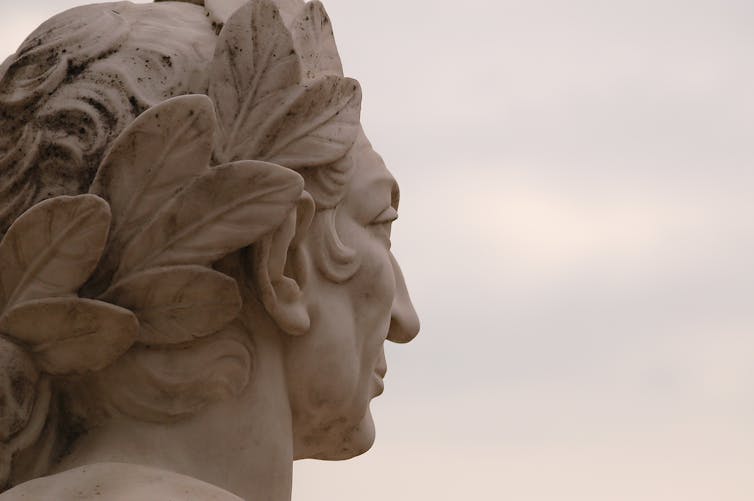 |
| Duccio Maesta - Panels 1308-11, Christ and the Woman of Samaria. Tempera and gold on panel. Museo Thyssen Bornemisza, Madrid (133 (1971.7). © Copyright Museo Thyssen-Bornemisza, Madrid |
By Louise Bourdua, University of Warwick
 |
Simone Martini, The Angel Gabriel, about 1326-34, Tempera on poplar. Collection KMSKA - Flemish Community Photograph: Hugo Maertens |
First, it was many years in the making. Its curator, Professor Emerita Joanna Cannon of the Courtauld Institute of Art, had been working on it for a decade or so. Duccio, one of the exhibition’s featured artists and one of the greatest Italian painters of the middle ages, had a major show in Siena in 2003. Another featured artist, Ambrogio Lorenzetti, had a smaller exhibition in the same city in 2017.
Second, the National Gallery’s late medieval Italian paintings had not been seen for two years because of the refurbishment of the Sainsbury Wing. That is, except for a select few displayed in an excellent exhibition on Saint Francis of Assisi in 2023.
Last, there was the publicity generated by the Metropolitan Museum’s iteration of this show – complete with a tantalising video tour by two of its curators.
The National Gallery’s take on the most exciting 50 years of Siena’s artistic production makes the most of its ground floor gallery rooms, enabling conversations between objects and medium.
The exhibition is a remarkable achievement: a pleasure for the eye and commendable for its ability to make medieval religious art accessible.
Britain’s love affair with Sienese painting is well documented from the late 19th century at least. But this exhibition focuses on much more than the celebrated four painters – Duccio, Simone Martini and Ambrogio Lorenzetti and his brother Pietro.
The wealth of Siena’s visual culture is represented with illuminated manuscripts; sculptures in marble, ivory, terracotta and walnut; reliquaries (containers for holy relics) and croziers (hooked staves) made from gold and enamel; and rugs and silks.
 |
Simone Martini, The Way to Calvary. Tempera on poplar. Musee du Louvre, Département des Peintures, Paris. (INV 670 bis) RMN Grand Palais Musee du Louvre/Gerard Blot |
Ambrogio Lorenzetti’s Annunciation (1344) is defined only by lines brushed on wet plaster using a red pigment (sinoper). This was a common initial step to set the composition, over which another layer of plaster would be applied again with contours painted but now filled with colour.
In another room, a beautifully modelled painted head of Jesus split into two, carved by Lando di Pietro (1338), is all that remains of a larger crucifix after bombing by allies in the second world war. It is the only known work of the sculptor. He was identified by the personal handwritten prayers concealed within the sculpture, which are displayed next to it.
The showstoppers
The curators have managed to do what could not be achieved in Siena in 2003: bring Duccio’s three triptychs into a single venue. The first two are shown just a few metres apart, to enable comparison and close viewing of all sides. Their painted backs and the geometric motifs behind their folding wings enable us to understand them as three-dimensional, portable objects.
The Crucifixion triptych, bought by Prince Albert in 1845 and lent to the exhibition by King Charles, is not too far from the pair, inviting comparison.
Duccio’s Healing of the Man Born Blind finds itself reunited with seven of its companions for the first time since 1777. This is the closest reconstruction we’ll ever get of the back predella (a box-like shelf with images that supported the main panels) of Siena cathedral’s enormous double-sided high altarpiece (known as the Maestà), which was carried in procession through the city streets in 1311.
Originally painted on a massive horizontal poplar plank, the individual episodes depicting Jesus’s ministry were sold on the art market in the 19th century and dispersed across two continents. A ninth panel which probably started the narrative has never been found, although you wouldn’t know it from this display.
The other showstopper is Pietro Lorenzetti’s altarpiece. It’s usually on the high altar of the church of Santa Maria della Pieve in Arezzo, but has been lent by the diocese and placed on a low plinth. This allows us to imagine just how immense Duccio’s Maestà must have been.
This altarpiece represents the most popular formula created in early 14th-century Siena. These were large polyptychs of five (or seven) vertical panels usually displaying the virgin and child in the centre, surrounded by saints relevant to the locality and patrons.
The Arezzo polyptych is approximately three metres in height and width, with three registers but has lost its predella, having been dismantled and relocated several times. The type was so popular that it, and the Sienese painters who created it, were in demand throughout Tuscany and beyond.
Each of the objects displayed in this exhibition merits a long look. Since there are over 100, my last reflection will be on another extraordinary reunion: a small gilded glass icon depicting once again the virgin, child and saints above the Annunciation (1347). Its double-sided reliquary frame still contains 17 relics.
It’s conceived as a miniature altarpiece, imitating the basic shape of the larger Sienese altarpieces on display. It also uses the same materials in addition to glass that has been gilded, incised and painted in red, blue and green.
Such precious materials and meticulous craft testify to the richness of Sienese art during the first half of the 14th century.
Siena: The Rise of Painting, 1300-1350 is at the National Gallery until June 22.![]()
Louise Bourdua, Professor of Art History, University of Warwick
















